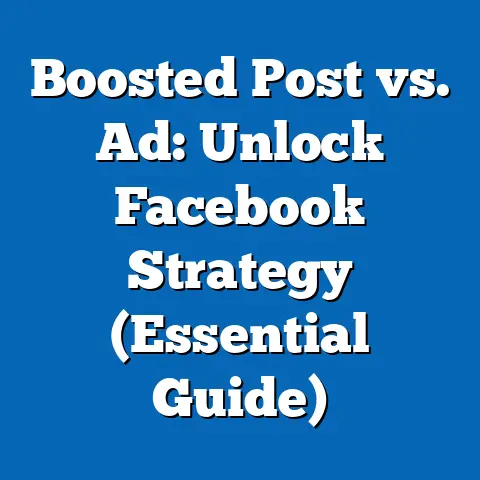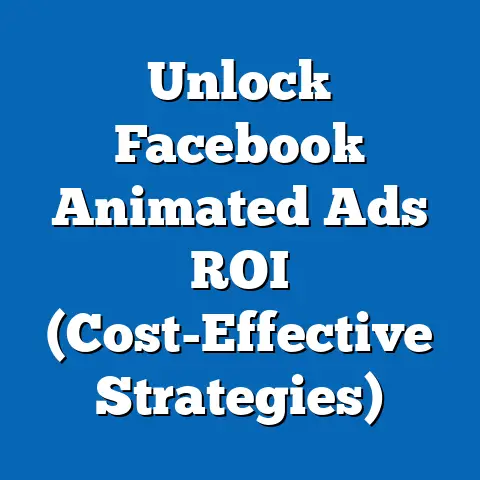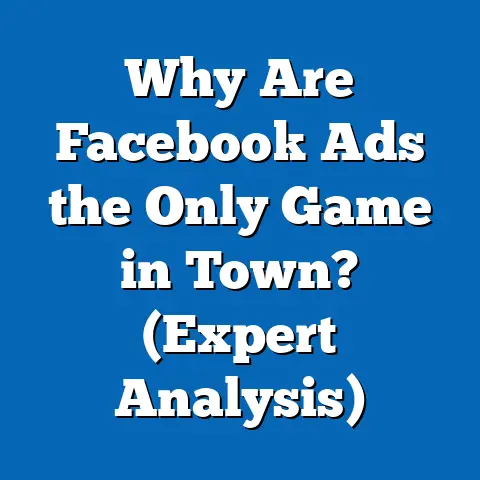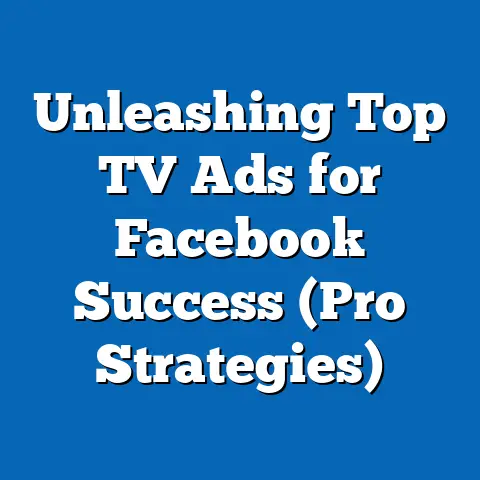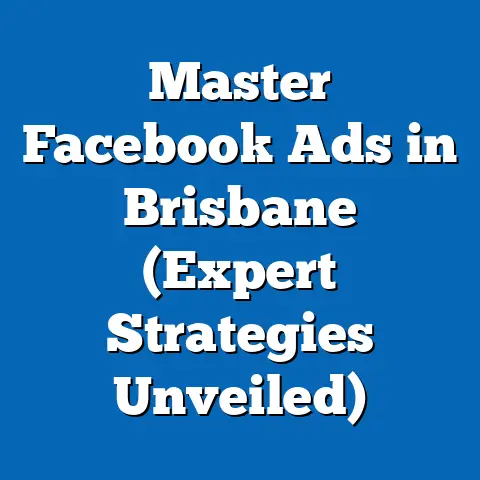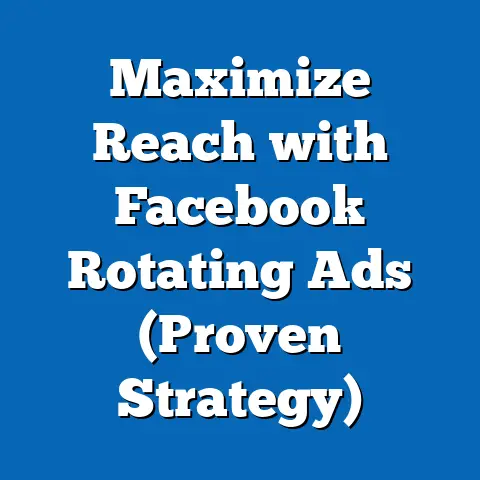Maximize Facebook Ads: Proven Strategies (Expert Insights)
Facebook advertising. It’s a phrase that can either excite you with the potential of reaching billions or fill you with dread at the thought of another wasted budget. In today’s digital landscape, though, it’s undeniable: if you want to connect with your audience, Facebook is a key player.
I’ve seen businesses thrive and campaigns skyrocket, all thanks to a well-executed Facebook ad strategy. But I’ve also witnessed countless dollars vanish into the digital ether because of poorly planned and managed campaigns. That’s why I believe it’s crucial to approach Facebook advertising not just as a marketing expense, but as a strategic investment. When done right, it can deliver incredible returns.
Think about it: where else can you target your ideal customer with such precision, delivering personalized messages directly to their newsfeed? Social media has become the digital town square, and Facebook, with its massive user base, is arguably the busiest corner. The potential reach is staggering. I’ve worked with small businesses that have seen their sales double, simply by implementing targeted Facebook ads.
However, unlocking that potential requires more than just boosting a post. It demands a deep understanding of the platform, a strategic approach, and a willingness to adapt. That’s what this article is all about. I’m going to share proven strategies and expert insights that I’ve gathered over years of managing Facebook ad campaigns, helping you maximize your ad performance and turn those marketing dollars into a real return on investment. Let’s dive in.
Understanding the Facebook Advertising Ecosystem
The Facebook advertising ecosystem is a complex, interconnected web, but understanding its key components is crucial for success. Think of it as learning the rules of a game before you start playing. You wouldn’t try to win a chess match without knowing how the pieces move, right? The same applies to Facebook ads.
Let’s break down the main players:
-
Audience Insights: This is your research lab. It allows you to delve deep into the demographics, interests, and behaviors of your target audience. I use it extensively to understand who my ideal customer really is, not just who I think they are.
-
Ads Manager: This is your control center. It’s where you create, manage, and analyze your ad campaigns. It’s a powerful tool, but it can be overwhelming at first. Don’t worry, we’ll cover the essentials.
-
Ad Formats: Facebook offers a variety of ad formats to suit different objectives, from simple image ads to immersive video experiences. Some popular options include:
- Carousel Ads: Showcase multiple products or features in a single ad.
- Video Ads: Capture attention with engaging video content.
- Slideshow Ads: Create a video-like experience with a series of images.
- Collection Ads: Allow users to browse and purchase products directly from the ad.
-
The Facebook Algorithm: Ah, the mysterious algorithm! This is the engine that determines which ads are shown to which users. It’s constantly evolving, but the basic principle remains the same: Facebook wants to show users content that they find relevant and engaging. This means that understanding your audience and creating high-quality ads is paramount.
Audience Insights: This is your research lab. It allows you to delve deep into the demographics, interests, and behaviors of your target audience. I use it extensively to understand who my ideal customer really is, not just who I think they are.
Ads Manager: This is your control center. It’s where you create, manage, and analyze your ad campaigns. It’s a powerful tool, but it can be overwhelming at first. Don’t worry, we’ll cover the essentials.
Ad Formats: Facebook offers a variety of ad formats to suit different objectives, from simple image ads to immersive video experiences. Some popular options include:
- Carousel Ads: Showcase multiple products or features in a single ad.
- Video Ads: Capture attention with engaging video content.
- Slideshow Ads: Create a video-like experience with a series of images.
- Collection Ads: Allow users to browse and purchase products directly from the ad.
The Facebook Algorithm: Ah, the mysterious algorithm! This is the engine that determines which ads are shown to which users. It’s constantly evolving, but the basic principle remains the same: Facebook wants to show users content that they find relevant and engaging. This means that understanding your audience and creating high-quality ads is paramount.
The algorithm considers numerous factors when deciding which ads to show, including:
Understanding the Facebook algorithm is key to optimizing your campaigns. I’ve found that focusing on creating highly relevant and engaging ads that resonate with my target audience always leads to better results.
Finally, let’s talk about key metrics. These are the numbers that tell you how your ads are performing. Some of the most important metrics include:
- Cost Per Click (CPC): The average amount you pay for each click on your ad.
- Click-Through Rate (CTR): The percentage of people who see your ad and click on it.
- Return on Ad Spend (ROAS): The revenue you generate for every dollar you spend on advertising.
- Conversion Rate: The percentage of people who click on your ad and complete a desired action, such as making a purchase or filling out a form.
- Cost Per Acquisition (CPA): The average cost of acquiring a new customer through your ad campaign.
These metrics are your compass and map. Without them, you’re sailing blind. I regularly monitor these metrics to identify areas for improvement and ensure that my campaigns are delivering a positive ROI.
Key Takeaway: Understanding the Facebook advertising ecosystem, including the algorithm, ad formats, and key metrics, is essential for creating successful campaigns. Make sure you familiarize yourself with these components before diving in.
Defining Your Target Audience
You might think you know your target audience. You might even have a detailed buyer persona sketched out. But are you really connecting with them on Facebook? Truly understanding your audience is the cornerstone of any successful Facebook ad campaign. After all, you wouldn’t try to sell snow to Eskimos, would you?
The beauty of Facebook advertising lies in its powerful targeting capabilities. You can reach specific groups of people based on a wide range of factors, including:
- Demographics: Age, gender, location, education, job title, and more.
- Interests: Hobbies, passions, and things they’re interested in.
- Behaviors: Purchase history, online activity, and device usage.
- Custom Audiences: Upload your own customer data (email lists, phone numbers, website visitors) to create highly targeted audiences.
- Lookalike Audiences: Find new customers who are similar to your existing customers.
The difference between broad and narrow targeting is crucial. Broad targeting casts a wide net, reaching a large audience with less specific interests. This can be useful for brand awareness campaigns, but it often results in lower conversion rates. Narrow targeting, on the other hand, focuses on a smaller, more defined audience with specific interests and behaviors. This can lead to higher conversion rates and a better ROI.
I’ve found that the sweet spot often lies somewhere in between. You want to be specific enough to reach your ideal customer, but not so narrow that you limit your reach.
Creating Effective Buyer Personas:
Buyer personas are fictional representations of your ideal customers. They help you understand their motivations, goals, and pain points. A good buyer persona should include:
- Demographics: Age, gender, income, location, education.
- Psychographics: Values, interests, lifestyle.
- Goals and Challenges: What are they trying to achieve? What are their biggest obstacles?
- Pain Points: What problems are they trying to solve?
- Preferred Communication Channels: Where do they spend their time online?
Once you have a clear understanding of your buyer personas, you can use this information to refine your audience targeting on Facebook.
A/B Testing Audience Segments:
A/B testing is a powerful technique for optimizing your Facebook ad campaigns. It involves creating two or more versions of your ad and showing them to different audience segments to see which performs best.
I always recommend A/B testing different audience segments to determine which groups yield the best results. For example, you could test targeting people based on their interests versus targeting people based on their behaviors. Or you could test different age ranges or locations.
Expert Tip: Don’t just guess at your target audience. Use Facebook Audience Insights to research their demographics, interests, and behaviors. The more you know about your audience, the better you can target your ads. I once worked with a client who thought their target audience was young professionals. After digging into Audience Insights, we discovered that their real audience was stay-at-home parents looking for ways to earn extra income. This simple shift in targeting led to a significant increase in conversions.
Key Takeaway: Defining your target audience is crucial for Facebook ad success. Use Facebook’s targeting options, create detailed buyer personas, and A/B test different audience segments to optimize your campaigns.
Crafting Compelling Ad Copy and Visuals
You’ve nailed your targeting, you’ve got your budget in place, but now comes the real test: can you capture attention and persuade your audience to take action? This is where compelling ad copy and visuals come into play. Think of your ad as a tiny billboard vying for attention in a crowded digital highway.
The creative is the heart and soul of your Facebook ad. It’s what grabs attention, communicates your message, and drives action. A poorly designed ad, no matter how well-targeted, is likely to be ignored.
Writing Engaging Ad Copy:
Your ad copy should be clear, concise, and compelling. It should speak directly to your target audience and highlight the benefits of your product or service.
Here are some tips for writing effective ad copy:
- Know Your Audience: Use language and tone that resonates with your target audience.
- Highlight Benefits: Focus on what your product or service can do for the customer, not just its features.
- Use Emotional Triggers: Tap into your audience’s emotions to create a connection.
- Include a Clear Call-to-Action: Tell people exactly what you want them to do (e.g., “Shop Now,” “Learn More,” “Sign Up”).
- Keep it Short and Sweet: People have short attention spans, so get to the point quickly.
- Use Power Words: Words like “Free,” “New,” “Exclusive,” and “Limited Time” can grab attention and create a sense of urgency.
- Ask Questions: Engage your audience by asking questions that pique their interest.
The Power of Visuals:
Visuals are just as important as ad copy. A high-quality image or video can grab attention and communicate your message more effectively than words alone.
Here are some best practices for visuals:
- Use High-Quality Images and Videos: Avoid blurry or pixelated images.
- Optimize for Mobile: Most people view Facebook ads on their mobile devices, so make sure your visuals are optimized for smaller screens.
- Use Eye-Catching Colors: Choose colors that stand out and grab attention.
- Showcase Your Product or Service: Use visuals to demonstrate the benefits of your product or service.
- Tell a Story: Use visuals to tell a compelling story that resonates with your audience.
- Keep it Consistent: Use consistent branding and visuals across all your ads.
User-Generated Content and Testimonials:
User-generated content (UGC) and testimonials can be incredibly powerful for building credibility and trust. When people see that other customers are happy with your product or service, they’re more likely to trust your brand.
I’ve seen firsthand how effectively UGC and testimonials can boost ad performance. I once ran a campaign for a local restaurant that featured photos and videos of customers enjoying their meals. The ads generated significantly more engagement and conversions than ads that featured professional food photography.
Expert Insight: Don’t underestimate the power of visuals. A great image or video can make all the difference in capturing attention and driving engagement. I recommend testing different visuals to see which ones resonate best with your audience. Also, consider using user-generated content and testimonials to build credibility and trust.
Key Takeaway: Compelling ad copy and visuals are essential for Facebook ad success. Write engaging ad copy that highlights the benefits of your product or service, and use high-quality visuals that capture attention and tell a story.
Budgeting and Bidding Strategies
So, you’ve got your target audience dialed in, your ad copy is killer, and your visuals are stunning. Now comes the crucial question: how much should you spend, and how should you bid?
This is where many advertisers stumble. They either spend too much without seeing results, or they underspend and miss out on potential opportunities. Finding the right balance is key.
Allocating Budgets Effectively:
Facebook offers two main budget options:
- Daily Budget: The average amount you’re willing to spend each day.
- Lifetime Budget: The total amount you’re willing to spend over the entire duration of your campaign.
I typically recommend starting with a daily budget, as it gives you more flexibility to adjust your spend based on performance. However, a lifetime budget can be useful for campaigns with a specific end date, such as a promotion or event.
How much should you spend? That depends on a variety of factors, including:
- Your Target Audience: The size and competitiveness of your target audience.
- Your Campaign Goals: What are you trying to achieve (e.g., brand awareness, lead generation, sales)?
- Your Industry: The average cost per click (CPC) in your industry.
- Your Ad Quality: The relevance and engagement of your ads.
As a general rule, it’s better to start small and gradually increase your budget as you see positive results. I often start with a daily budget of \$25-\$50 and then scale up as my campaigns become more profitable.
Bidding Strategies:
Facebook offers several bidding strategies to choose from:
- Automatic Bidding: Facebook automatically sets your bids to get you the most results for your budget.
- Manual Bidding: You set your own bids for each click or impression.
Automatic bidding is a good option for beginners, as it takes the guesswork out of setting bids. However, manual bidding can give you more control over your ad spend and allow you to optimize your bids based on performance.
When using manual bidding, it’s important to monitor your bids closely and adjust them based on your results. If you’re not getting enough impressions or clicks, you may need to increase your bids. If you’re spending too much without seeing results, you may need to decrease your bids.
Leveraging Seasonal Trends and Events:
Seasonal trends and events can be a great opportunity to maximize your budget effectiveness. For example, if you’re selling holiday gifts, you’ll want to increase your ad spend during the holiday season. Or if you’re running a promotion for a specific event, you’ll want to target people who are interested in that event.
I always recommend planning your ad campaigns around seasonal trends and events. This can help you reach a larger audience and drive more conversions.
Expert Insight: Don’t be afraid to experiment with different budgeting and bidding strategies. There’s no one-size-fits-all approach. The key is to monitor your results closely and adjust your strategy based on what works best for your business. I once ran a campaign where I initially used automatic bidding. After a few weeks, I switched to manual bidding and was able to significantly lower my cost per click.
Key Takeaway: Allocate your budget effectively by considering your target audience, campaign goals, and industry benchmarks. Experiment with different bidding strategies and leverage seasonal trends and events to maximize your budget effectiveness.
Analyzing and Optimizing Campaign Performance
You’ve launched your campaign, the ads are running, and the clicks are coming in. But the work doesn’t stop there. In fact, it’s just beginning.
Analyzing and optimizing your campaign performance is crucial for maximizing your ROI and achieving your advertising goals. Think of it as fine-tuning a musical instrument. You wouldn’t expect to play a perfect melody without tuning your instrument first, would you?
Tracking and Analyzing Ad Performance:
Facebook provides a wealth of data to help you track and analyze your ad performance. You can use Facebook Analytics and Ads Manager to access this data.
Some of the key metrics to track include:
- Impressions: The number of times your ad was shown.
- Reach: The number of unique people who saw your ad.
- Clicks: The number of times people clicked on your ad.
- Click-Through Rate (CTR): The percentage of people who saw your ad and clicked on it.
- Cost Per Click (CPC): The average amount you paid for each click.
- Conversions: The number of people who completed a desired action, such as making a purchase or filling out a form.
- Conversion Rate: The percentage of people who clicked on your ad and completed a conversion.
- Cost Per Acquisition (CPA): The average cost of acquiring a new customer through your ad campaign.
- Return on Ad Spend (ROAS): The revenue you generate for every dollar you spend on advertising.
I recommend tracking these metrics on a regular basis (at least once a week) to identify areas for improvement.
Optimizing Underperforming Ads:
If you notice that some of your ads are underperforming, don’t panic. There are several things you can do to optimize them:
- Adjust Your Targeting: Make sure you’re targeting the right audience.
- Modify Your Ad Copy: Try different headlines, descriptions, and calls-to-action.
- Change Your Visuals: Experiment with different images and videos.
- Reallocate Your Budget: Focus your budget on the ads that are performing best.
- A/B Test: Create multiple versions of your ad and test them against each other to see which performs best.
Continuous Learning and Adaptation:
The Facebook advertising landscape is constantly changing. New features are introduced, algorithms are updated, and consumer behaviors evolve. That’s why it’s important to be a continuous learner and adapt your strategies based on performance trends and audience feedback.
I spend a significant amount of time reading industry blogs, attending webinars, and experimenting with new features to stay up-to-date on the latest trends.
Expert Insight: Don’t set it and forget it. Facebook ad campaigns require ongoing monitoring and optimization. I recommend setting aside time each week to analyze your performance data and make adjustments as needed. I once had a campaign that was performing well for several weeks, but then suddenly started to decline. After analyzing the data, I discovered that my target audience was experiencing ad fatigue. I refreshed my ad creative and saw an immediate improvement in performance.
Key Takeaway: Track and analyze your ad performance data to identify areas for improvement. Optimize underperforming ads by adjusting your targeting, modifying your ad copy, or changing your visuals. And always be a continuous learner and adapt your strategies based on performance trends and audience feedback.
Conclusion
Facebook advertising is an investment, not an expense. By understanding the platform, defining your target audience, crafting compelling ads, budgeting effectively, and analyzing your results, you can maximize your ROI and achieve your advertising goals.
I’ve shared proven strategies and expert insights that I’ve gathered over years of managing Facebook ad campaigns. Now it’s time to put these strategies into action.
I encourage you to take a proactive approach to implementing these strategies in your campaigns. Don’t be afraid to experiment, test new ideas, and learn from your mistakes. The more you experiment, the more you’ll learn about what works best for your business.
So, what are you waiting for? Start experimenting with your ads today and see the tangible results for yourself. Your next successful Facebook ad campaign starts now!

